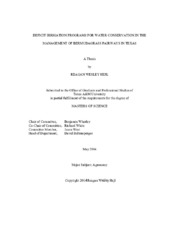| dc.description.abstract | Golf course water use in Texas has become increasingly regulated in the past
decade due to persistent drought conditions, diminishing water supplies, and rapidly a
growing population. Many golf courses have been faced with considerable cutbacks in
irrigation allocations, but information is limited regarding critical levels needed for
maintaining adequate turf quality, persistence, and recovery from divots and traffic.
Furthermore, the effects of irrigation water quality on minimal irrigation requirements
has not been fully resolved. A series of field and greenhouse studies were conducted
over the course of two years in College Station, TX, to determine the effects of
continuous reference evapotranspiration (ET_(o))- based deficit irrigation levels on quality
of bermudagrass fairway turf. Turf quality evaluations from both seasons showed that in
the absence of traffic, irrigation levels of 0.3 x ET_(o) were sufficient to maintain
acceptable turfgrass quality during summer months (at a 3-day per week irrigation
frequency). Canopy temperatures increased considerably as irrigation was reduced; with
up to a 20℃ increase detected between irrigated and unirrigated plots. Upon resumption
of full irrigation levels in September, unirrigated and deficit-irrigated plots quickly
recovered to ~90% green cover within 8 weeks in year 1. However, unirrigated plots
were much slower to recover in the second season, only reaching ~30% green cover by 8
weeks. The delayed ability of unirrigated plots to rebound following successive years
without irrigation suggests a cumulative effect of drought stress on bermudagrass health
and vigor. Traffic treatments delayed recovery across all irrigation levels. Greenhouse
investigations into irrigation water quality (reverse osmosis (RO), saline, and sodic) and plant growth regulator trinexapac-ethyl (TE) effects on bermudagrass evapotranspiraton and tolerance to deficit irrigation were also undertaken. Irrigation water quality failed to significantly influence minimal irrigation requirements, but turf irrigated with sodic irrigation did exhibit considerably higher evapotranspiration (ET) rates relative to those receiving saline or RO irrigation. TE improved bermudagrass quality and delayed leaf firing under the soil moisture stress from deficit irrigation. The findings from this research provide timely and practical information for turf managers who must increasingly utilize ET-based irrigation scheduling and/or low-quality water sources in the management of golf course turfgrass systems. | en |


